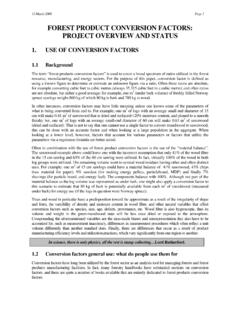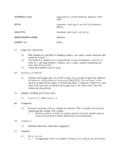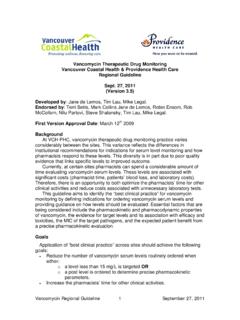Transcription of Paper number 120 ENVIRONMENT DEPARTMENT …
1 Printed on recycled Paper stock, using soy DEPARTMENT PAPERSS ustainable Development Vice PresidencyEnvironment DepartmentTHE WORLD BANK1818 H Street, NWWashington, 20433 Telephone: 202-473-3641 Facsimile: 202-477-0565 Paper number 120 Environmental Economics SeriesBiodiversity, Ecosystem Services, and Climate ChangeThe Economic ProblemCharles PerringsNovember 2010 Papers in this series are not formal publications of the World Bank. They are circulated to encourage thought and discussion. The use and citation of this Paper should take this into account.
2 The views expressed are those of the authors and should not be attributed to the World Bank. This book is available on-line from the ENVIRONMENT DEPARTMENT of the World Bank at: , Ecosystem Services, and Climate Change The Economic ProblemCharles PerringsThe World Bank ENVIRONMENT deparTmenTNovember 2010 The International Bank for Reconstructionand Development/THE WORLD BANK1818 H Street, , 20433, in the United States of AmericaFirst published November 2010 Design: Jim CantrellCover photos: Hidajet Delic-Degi / The World Bank Photo Library.
3 Bosnia and Herzegovina; farm and forest land. iiiEnvironmental Economics Series ContentsExecutive Summary 1 Chapter 1 Introduction 3 Chapter 2 Biodiversity and Climate Change 5 Chapter 3 Estimating the Value of Biodiversity-Related Changes in Ecosystem Services 11 Chapter 4 Re-evaluating Biodiversity and Climate Change 15 Chapter 5 Discussion and Conclusions 23 Appendix Developments in the Economics of Biodiversity and Ecosystem Services 27 References 33 Figures 1 Impact of climate change on the invasibility of
4 Ecosystems 7 2 Quantile regression results for climate and the threatened status of birds, plants, reptiles and mammals showing the impact of quantiles (horizontal axis) on the climate coefficient (vertical axis) 17 3 The relation between outbreaks of notifiable animal diseases and value at risk, 1996 2004 20 Table 1 Economic losses to introduced pests in crops, pastures, and forests in the United States, United Kingdom, Australia, South Africa, India, and Brazil (billion dollars per year) 191 Environmental Economics Series Executive SummaryClimate change is both a cause and an effect of biodiversity change.
5 Climate change is amongst the most important determinants of change in the distribution and abundance of species in both managed ecosystems such as agriculture, production forests, cities and many coastal zones, and natural terrestrial and marine ecosystems. Climate change is also an effect of land uses that generate greenhouse gases (CO2, CH4, N2O) and of alteration in biological stocks of carbon in terrestrial and marine system (green and blue carbon). Biodiversity change affects the flow of ecosystem services the benefits that people get from ecosystems.
6 These benefits include the Millennium Assessment s provisioning services (production of foods, fuels, fibers, water, genetic resources), cultural services (recreation, spiritual and aesthetic satisfaction, scientific information), and regulating services (controlling variability in production, pests and pathogens, environmental hazards, and many key environmental processes). Amongst the ecosystem services supported by biodiversity is climate regulation. One effect of the conversion of forests to agricultural production, for example, is an increase in carbon emissions from land clearance and a decrease in sequestered carbon.
7 Both effects increase the rate of climate change. At the same time, our ability to adapt to climate change depends on the diversity of species within functional groups. If the species in a particular functional group ( , domesticated grains) include some that are suited to conditions expected to occur with climate change, the cost of adaptation to climate change will be low. Biodiversity loss increases both the severity of climate change and our ability to adapt to it. Neither effect is signaled in current prices. Both are external to existing economics of biodiversity-climate linkages deals with these externalities.
8 There are two tasks. One is to identify the causal connections between biodiversity change, climate change and the production of ecosystem services. A second is to identify the marginal value of climate-related changes in biodiversity. The role of living organisms in the production and sequestration of greenhouse gases is reasonably well understood. The consequences for climate of changes in the extent of tropical forests, or phytoplankton in the oceans are already incorporated in general circulation models. Ecologists also agree that climate change is already changing the world s biota.
9 It is affecting species distributions and abundance, the timing of reproduction in animals and plants, animal and bird migration patterns, and the frequency and severity of pest and disease outbreaks. Species are moving from lower to higher elevations, and from lower to higher latitudes. Species that are unable to move are at risk. At the same time, changes in the world s biota from other causes are affecting the ability of ecosystems to adapt to climate change. The simplification of many ecosystems to make them more useful to people reduces their flexibility.
10 By eliminating species that are redundant given current climatic conditions and current uses, we have reduced the capacity of many ecosystems to function if climatic conditions change. ENVIRONMENT DEPARTMENT Papers2 Biodiversity, Ecosystem Services, and Climate Change The Economic Problem Although science has made progress in understanding and modeling the linkages between the structure of ecosystems, biodiversity and the production of ecosystem services, there are few studies of the two-way interactions between biodiversity and climate change.















